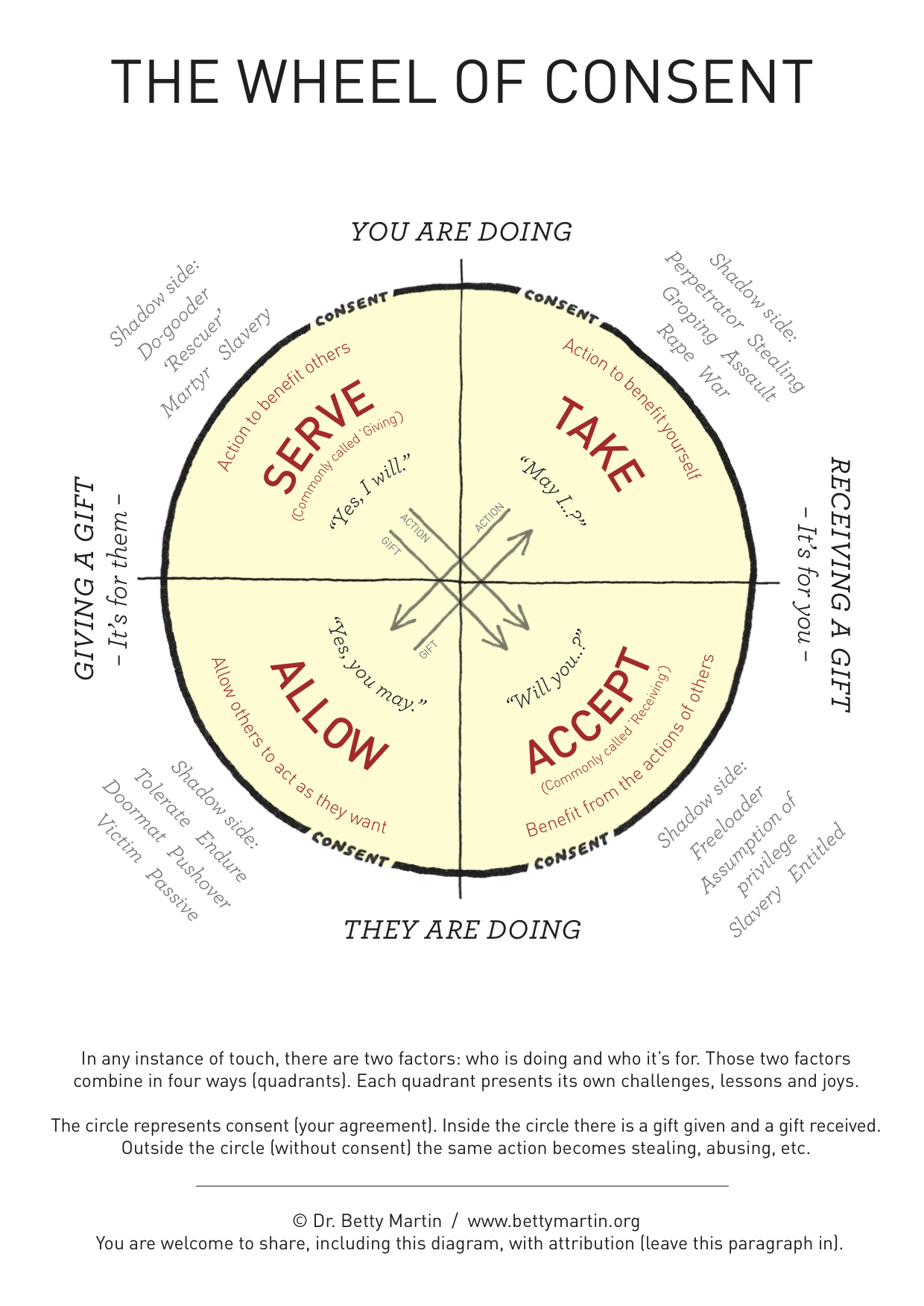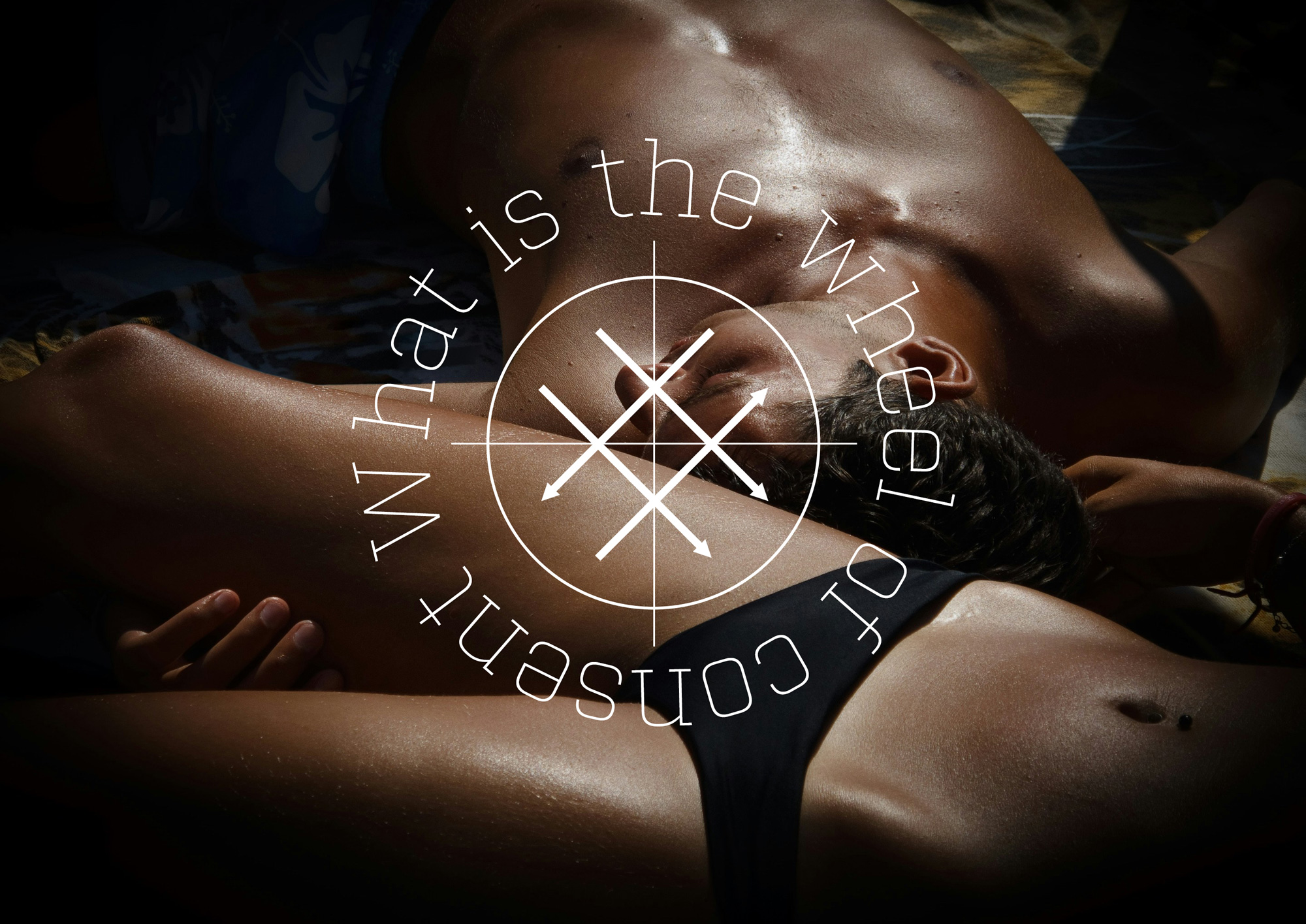In the lyrics of Primal Scream “Just what is it that you want to do?” when it comes to sex, you know the answer—We wanna have a good time, and do what we wanna do! But as grown-up people we know that doing what and who we want comes with responsibilities to ourselves and each other. Consent and communication are the key components to getting it right and having that all important good time! But we humans are complicated beings and the wheel of consent can help us massively.
What if I want you to spank me but you’re not sure you want to do it? You want to please me so you say yes with the all-important enthusiasm but you’re left with complicated feelings. Would I be forcing you into something without realising it? If I found out later that you weren’t sure, would that make it non-consensual, or leave me feeling like I’d taken advantage? Or what if one lover likes being tickled and the other hates it but will tolerate it for the sake of the lusty moment?
There’s usually a lot of baggage when it comes to sex—fear of rejection, fear of judgement, fear of letting our lovers down, fear of being let down. How can we possibly be sure that everyone is getting what they want and need from our sexytime action?
Like we mentioned, super complicated!
But did you know there’s a thing called the Wheel of Consent which can help unravel these complexities and work out just what is happening when it comes to consensual partnered contact.
We asked sex expert Suzannah Weiss to tell us more and unlock the secrets of a truly honest connection using this method.
What is the Wheel of Consent
We often think of getting consent as a very simple interaction: You ask someone if they’d like to engage in a sexual activity, and they respond “yes” or “no.” But consent is actually much richer and more multifaceted than that. It’s an ongoing discussion that allows both people to tune into their own bodies and their partners’ bodies, exploring how different kinds of touch feel to them and what they like inside and outside the bedroom.
One way that anyone can better understand consent and practice it in a connective, informative manner is by learning something known as the Wheel of Consent. The Wheel of Consent, created by sex educator Betty Martin, maps out various ways of giving and receiving touch. Based on it, you can do exercises with your partner that allow you to experience different forms of relating.
The structure of the wheel?
You can see a picture of the Wheel of Consent here. The activities on it run along two axes: One spanning from “you are doing” to “they are doing,” and one spanning from “it’s for them” to “it’s for you.” Based on these four poles, the wheel itself is divided into four quadrants: “serve” (you are in the active or “doing” role, and you are giving for a partner’s pleasure), “take” (you are in the “doing” role, and you are receiving something for your pleasure), “accept” (your partner is doing something to you, and you are receiving it for your own pleasure), and “allow” (your partner is doing something to you for their own pleasure).
Here is an example: If you want to stroke your partner’s hair because you like how it feels against your fingers, you are in the “taking” position. However, if you do the same thing because your partner likes it when you stroke their hair, you are in the “serving” position. Similarly, if your partner gives you oral sex in order to please you, you are in the “accepting” position — but if they do so because that pleases them, you are “allowing.”
Many sexual and sensual activities you can do with a partner fall somewhere in the middle of the wheel. For instance, a partner may give you oral sex both for their pleasure and for your pleasure, which would land somewhere between “allow” and “accept.”
Another way to conceptualise the Wheel of Consent is “I touch you the way you want” (serving), “I touch you the way I want” (taking), “you touch me the way you want” (allowing), and “you touch me the way I want” (accepting).

Why the Wheel of Consent matters?
Sometimes, you might ask for consent for a given activity, but your partner may not have all the information they need to answer because they don’t understand the activity’s purpose. For instance, if you think your partner could use a back rub and ask if you can give them one, they might say “yes” because they think you want to touch them for your own sake. This doesn’t make the back rub non-consensual, but the communication would be clearer if they knew you were thinking about their own needs. Then, they’d have the chance to say, “I’m good right now, thank you” without worrying about disappointing you.
The same kind of situation can arise in non-sexual situations. You might offer to make pizza for you and your partner, for example, because you think they’d like it — but they might agree because they think you want it. Or, maybe you do want it for yourself, but they say “no” because they think your offer is primarily for their sake. To avoid these situations, it is helpful to communicate who the activity will be done primarily for.
Playing with the Wheel of Consent
If you’d like to explore different kinds of touch and communication with a partner, you can go through each quadrant on the wheel of consent and take turns being in each role. This allows you to practice asking for and giving consent and also gives you the chance to see which role(s) you most like to take on. If it’s your first time using the Wheel of Consent, it’s easiest to start off with a low-pressure, non-sexual activity, like non-genital touch.
For instance, you might start off in the serving position — touching your partner the way they want. To ask consent for this, you might say something like, “would you enjoy it if I stroked your hair?” Then, it is their job to let you know if they’d like that or if they’d prefer something else; they are in the accepting position.
Next, you can assume the taking position and touch your partner the way you want to touch them. In this case, you might ask, “can I run my hand up and down your leg?” — and they’ll respond with the knowledge that this is for your pleasure.
For the “accepting” role, you might ask, “would you please massage my shoulders?” and your partner will answer with the understanding that this is for your sake. Lastly, when you’re in the allowing position, you might ask your partner a question like “would you like to kiss me?” or “how would you like to touch me?”
Using the wheel in everyday life
You may not end up evoking the wheel of consent every time you’re intimate with a partner, but the question of whether you are doing or receiving — and for whose sake — may prove useful in many circumstances. As we already covered, it’s often helpful to state why you want to engage in a particular activity or form of touch so that your partner can answer in an informed manner.
The same exact activity can be done in different ways to cater to the giver, the receiver, or both. For instance, a partner might enjoy touching your breasts, but you may want your partner to touch them in specific ways that you enjoy. Knowing this can allow you to tell or show your partner how you like to be touched so that they can touch you in a way that pleases you both.
In addition, thinking about whether you prefer “doing” or having something done to you can help you to articulate your preferences in the bedroom, particularly when it comes to exploring dominant-submissive dynamics. Before engaging in a BDSM scene, you can use the Wheel of Consent to discuss not only who will be dominant and who will be submissive, but also who will be receiving pleasure — the dom, the sub, or both.
Whether or not you end up using the Wheel of Consent specifically, the main principle behind it can be useful for anyone’s sex life: Talk about what you like with your partner, and get specific when you ask for what you want — as well as when you ask them what they want. That way, everyone has a greater chance of getting their desires met.



